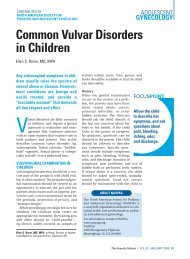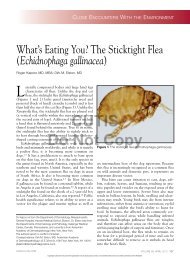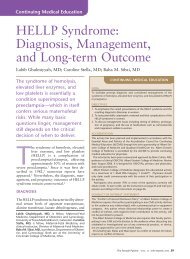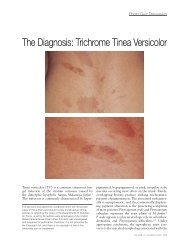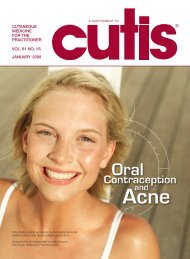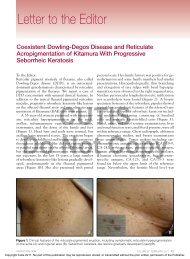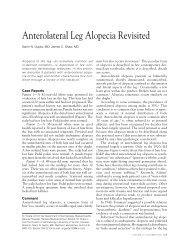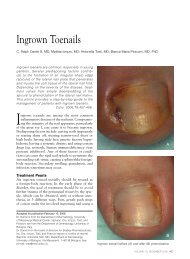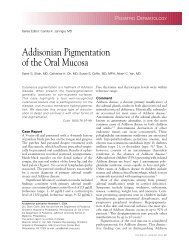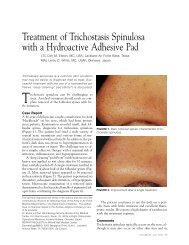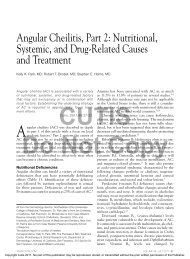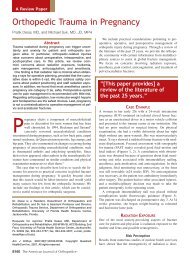Trolamine-Containing Topical Emulsion: Clinical Applications ... - Cutis
Trolamine-Containing Topical Emulsion: Clinical Applications ... - Cutis
Trolamine-Containing Topical Emulsion: Clinical Applications ... - Cutis
You also want an ePaper? Increase the reach of your titles
YUMPU automatically turns print PDFs into web optimized ePapers that Google loves.
Drug Therapy Topics<strong>Trolamine</strong>-<strong>Containing</strong> <strong>Topical</strong> <strong>Emulsion</strong>:<strong>Clinical</strong> <strong>Applications</strong> in DermatologyJames Q. Del Rosso, DO; Joseph Bikowski, MD<strong>Trolamine</strong>-containing topical emulsion is used to promoteand expedite wound healing. This agent hasbeen shown to recruit macrophages, which serveimportant functions in the wound healing process,and increase the IL-1:IL-6 ratio, which enhances formationof granulation tissue and collagen synthesis.Therapeutic applications have included acute radiationdermatitis and postoperative wounds, and applicationafter cryotherapy for actinic keratosis (AK).This article reviews the mechanism of action andinformation on clinical applications of trolaminecontainingtopical emulsion.<strong>Cutis</strong>. 2008;81:209-214.Management of cutaneous wounds continues tobe a challenge in dermatology. One challengeis finding topical agents that expedite thehealing process, depending on the type of wound andits cause. The management of postoperative woundsis another challenge, especially because habitualuse of some topical antibiotics post–dermatologicprocedures is associated with a high risk of allergiccontact dermatitis without proven benefit in the preventionof infection. 1 <strong>Trolamine</strong>-containing topicalAccepted for publication December 14, 2007.Dr. Del Rosso is from the Dermatology Residency Program, ValleyHospital Medical Center, Las Vegas, Nevada. Dr. Bikowski is fromOhio State University, Columbus, and Bikowski Skin Care Center,Sewickley, Pennsylvania.Dr. Del Rosso is a consultant, researcher, and speaker for Allergen,Inc; Barrier Therapeutics, Inc; CollaGenex Pharmaceuticals Inc;Coria Laboratories, Ltd; Doak Dermatologics, a subsidiary ofBradley Pharmaceuticals, Inc; Galderma Laboratories, LP;Intendis, Inc; Medicis Pharmaceutical Corporation; NovartisPharmaceuticals Corporation; OrthoNeutrogena; QLT Inc; RanbaxyPharmaceuticals Inc; SkinMedica, Inc; Stiefel Laboratories, Inc;Triax Pharmaceuticals; Unilever; and Warner Chilcott. Dr. Bikowskiis an advisory board member and consultant and is on thespeakers bureau for OrthoNeutrogena.Correspondence: James Q. Del Rosso, DO (jqdelrosso@yahoo.com).emulsion has been used for more than 3 decades inboth Europe and the United States for the managementof multiple conditions affecting skin integrity,such as radiation dermatitis and cutaneous wounds.In addition, trolamine-containing topical emulsionhas been used for many indications and dermatologicapplications, ranging from superficial wounds andskin ulcers to postoperative wounds (Table). 2,3What is the mechanism of action oftrolamine-containing topical emulsion?The trolamine-containing oil-in-water topical emulsionprovides both occlusive and hydrating properties,increases recruitment of macrophages towound sites to enhance healing at the dermal level,and stimulates formation of granulation tissue. Ina study of identical epidermal wounds in healthyvolunteers, researchers demonstrated that trolaminecontainingtopical emulsion is chemotactic for macrophages,the cells that serve to enhance formation ofgranulation tissue. 4Macrophages are capable of secreting the cytokineIL-6, which is known to accelerate epidermalgrowth and to inhibit the proliferation of fibroblasts.By down-regulating secretion of IL-6 and inducingIL-1 release, trolamine-containing topical emulsionincreases the IL-1:IL-6 ratio. 4 The end result of thesechanges in cytokine profile is granulation tissueformation and modulation of extracellular matrixreorganization by influencing collagen and collagenasesynthesis. These findings were confirmed in anex vivo study of the ability of trolamine-containingtopical emulsion to heal irradiated skin, which verifiedradiotherapy-induced modifications, includinga 50% reduction in basal cell proliferation. 5 In thefirst 24 hours, irradiated skin typically shows extensivevasodilation and altered capillary permeabilityaccompanied by decreased CD34 transmembraneprotein expression, which are factors that togetherVOLUME 81, MARCH 2008 209
Drug Therapy Topicscan result in cell necrosis. After application oftrolamine-containing topical emulsion to skin inthis study, collagen synthesis and IL-1a secretionwere enhanced, capillary alterations were decreased,and CD34 expression and epithelial cell proliferationwere restored. It was concluded that applicationof trolamine-containing topical emulsion madeit possible to modulate fibroblast metabolism andsubsequent collagen synthesis in a way that may beadvantageous in limiting postradiation fibrosis. 5How may trolamine-containing topical emulsionmodulate the wound-healing process?<strong>Trolamine</strong>-containing topical emulsion has beenshown to promote the wound-healing process.Wound healing is a complex biologic process involvinga complex interaction between many cell types,a variety of mediating secretions, and immunologicphenomena. 4,5 The process can be divided into thefollowing 3 phases: (1) hemostasis and inflammation;(2) cell migration and proliferation; and (3) skinremodeling. 6,7 Transition from one phase to anotheris not abrupt because there is overlap of the biologicprocesses that occur during wound healing.The hemostasis and inflammation phase includesthe time of skin injury through days 4 to 6. 3-7 Immediatelyafter a cutaneous wound occurs, plateletshelp to form a fibrin plug while growth factors andcytokines are being released and recruited into thearea of the injury. Within 24 hours, the inflammatorystage of healing coincides with the arrival ofneutrophils, which are involved with phagocytosis<strong>Trolamine</strong>-<strong>Containing</strong><strong>Topical</strong> <strong>Emulsion</strong> 2,3Indications and Dermatologic UsesFull-thickness wounds aSuperficial wounds aFirst- and second-degree burns,including sunburn aDermal ulcers aGraft site management aRadiation dermatitis aMinor abrasions aPostoperative woundsaIndication approved by US Food and Drug Administration.and wound debridement. Monocytes, transformedinto macrophages, arrive within 48 to 96 hours andplay an important role in wound healing.Cell migration and proliferation, the secondphase of wound healing, occurs from day 4 throughday 14. 6,7 After an injury to the skin, the nuclearfactor-kB pathway is activated through cytokinereceptors IL-1 and tumor necrosis factor-a, amongother chemokines, adhesion molecules, and cytokinesproduced by local tissue cells and migratingleukocytes. Continued migration of inflammatorycells and macrophages into the wound space ultimatelyleads to granulation tissue formation and reepithelializationas the infiltrating cells perform thefollowing: (1) consumption of bacteria via phagocytosis;(2) secretion of collagenases, which modulateswound debridement; (3) release of growth factors,which promotes angiogenesis and further healing;(4) stimulation of the deposition of new collagenformation by fibroblasts; and (5) recruitment offibroblasts and keratinocytes by macrophages. 6,7The final stage of wound healing is skin remodeling,which occurs from day 14 through 1 year. 6,7 Inthis final stage of wound healing, collagen depositedby fibroblasts is formed into an organized network.Within the wound, there is interaction betweencollagen degradation and new collagen production,as overall collagen formation increases to accommodatethe new thicker collagen that is oriented alongthe stress lines within the wound. 6,7 The durationof skin remodeling correlates with the depth of thewound, with the process continuing over weeks insuperficial wounds and for up to one year or morein deep wounds, though replacement tissue is notcreated with the degree of organization equivalentto that found in uninjured skin.<strong>Trolamine</strong>-containing topical emulsion appearsto promote and expedite healing by increasing thenumber of macrophages recruited to the injury site,thereby decreasing the time needed for healing. 2,4,5Macrophages have been referred to as the “orchestraleaders” of wound healing because their role is todirect the course of the wound-healing process. 7They serve to complete the debridement initiatedby neutrophils and participate directly in the inflammatorycascade with the release of cytokines andgrowth factors, which produces a cytokine profileconducive to wound healing. 4,5,7Is trolamine-containing topical emulsion helpfulin the treatment of radiation dermatitis?<strong>Trolamine</strong>-containing topical emulsion has a historyof use for radiation dermatitis, with information onits mechanistic role already reviewed. 2,3,8,9 The use210 CUTIS ®
Drug Therapy Topicsof ionizing radiation to treat primary tumors andpalliate metastatic disease sometimes may lead toacute or chronic skin injury. These insults are consideredadverse effects and are not fully amelioratedby the development of more modern equipment or ofmore sophisticated therapeutic regimens intended tominimize skin toxicity. Even with modernized equipmentand techniques, radiation-induced cutaneousinjury continues to be a challenging side effect, sometimesassociated with discomfort and pain, and it maylimit the duration of treatment or dose delivered. 9In addition to interfering with the normal maturation,reproduction, and repopulation of epidermaland hair matrix cells, radiotherapy targets bothfibroblasts and cutaneous vasculature. 9 A radiationinducedinjury is considered a complex wound inwhich adverse structural tissue changes occur immediatelyand are characterized by DNA damage andalteration of cellular proteins and lipids. Repeatedexposure to radiation contributes both to directtissue injury and impairment of healing via inhibitionof granulation tissue formation, fibrogenesis,and angiogenesis. 9For acute radiation dermatitis, trolaminecontainingtopical emulsion appears to reducediscomfort and provide moisturization; however,as with other topical formulations, it has notbeen proven to be radioprotective. 8-11 In one study,trolamine-containing topical emulsion was shownto prevent treatment delays or interruptions due toradiation-induced skin toxicity. The study demonstratedthat the overall treatment time of chemotherapyand radiotherapy was reduced because themodalities could be administered simultaneouslyrather than sequentially. 8What other uses of trolamine-containing topicalemulsion have been reported to be effective?Treatment of actinic keratosis (AK), especially withphysical modalities such as cryotherapy, causes disruptionof epithelium. The impact of trolaminecontainingtopical emulsion on the healing time oftreatment sites after cryotherapy for AK was evaluatedin an investigator-blinded pilot study (N540). 2,12Study participants with symmetric involvement ofAKs on the dorsal hands, dorsal forearms, forehead,and cheeks were treated with liquid nitrogen cryotherapyfollowed by twice-daily application of trolaminecontainingtopical emulsion to all treated targetregions on one side of the body and a designatedpetrolatum-based ointment (nonmedicated whiteTime to Complete Healing, d141210864209.0711.36Dorsal Hands(n13)10.2513.12Dorsal Forearms(n8)9.4012.60Forehead(n10)8.5510.88Cheeks(n9)Target Region<strong>Trolamine</strong>-containing topical emulsionNonmedicated moisturizerFigure 1. Mean time to complete healing of actinic keratosis site following cryotherapy and application of trolaminecontainingtopical emulsion or petrolatum-based ointment (nonmedicated moisturizer) to the dorsal hands, dorsalforearms, forehead, and cheeks. Reprinted from Del Rosso, 12 with permission from HMP Communications.VOLUME 81, MARCH 2008 211
Drug Therapy TopicsACBDFigure 2. Patient with surgical excision of a basal cell carcinoma on the right side of the upper cutaneous lip followedby second-intention healing before (A) and after application of trolamine-containing topical emulsion (B, 7 days; C,14 days; D, 21 days).petrolatum) twice daily on the other side of the body.The number of treated AKs in each target region onboth sides of the body was 5 on the dorsal hands,8 on the dorsal forearms, 5 on the forehead, and 5 onthe cheeks. The total number of target regions treatedwith liquid nitrogen cryotherapy was 13, 8, 10, and 9,respectively. None of the treated lesions were hypertrophicAKs. The mean time to complete healing wasreduced by at least 2.29 days in the treatment groupthat used the trolamine-containing topical emulsion,with results varying slightly based on the site treated(Figure 1). Complete healing at all cryotherapy-treatedsites was faster by 2.29 days, 2.87 days, 3.20 days,and 2.33 days on the dorsal hand, dorsal forearm,forehead, and cheek, sides that were treated withtrolamine-containing topical emulsion as comparedwith the sides treated with petrolatum-based ointment,respectively. 2,12<strong>Trolamine</strong>-containing topical emulsion also hasbeen reported to enhance wound healing after Mohsmicrographic surgery, excisional surgery, and otherdermatologic surgical procedures that are followedby second-intention healing, such as curettage andshave or saucerization techniques. 2,12,13 Figure 2demonstrates healing over 21 days from applicationof trolamine-containing topical emulsion aftersurgical excision of a basal cell carcinoma on the rightside of the upper cutaneous lip followed by secondintentionhealing. Figure 3 demonstrates healing over14 days from application of trolamine-containingtopical emulsion after curettage and electrodesiccationof a basal cell carcinoma on the left postauricularsurface followed by second-intention healing.What is the safety profile of trolaminecontainingtopical emulsion?No major adverse effects have been reported withtrolamine-containing topical emulsion. Local tolerabilityhas been excellent, with a low potential riskfor signs and/or symptoms of cutaneous irritation andlittle to no risk of contact sensitization. 2,8,10-13How does the use of trolamine-containingtopical emulsion differ from other topical agentscommonly used in dermatology for wounds thatare frequently encountered in clinical practice?In dermatology, commonly used topical agents fortreatment of cutaneous wounds, including those212 CUTIS ®
Drug Therapy TopicsABFigure 3. Patient with curettage and electrodesiccation of a basal cell carcinoma on the left postauricular surface followedby second-intention healing before (A) and 14 days after application of trolamine-containing topical emulsion (B).wounds that occur after surgical procedures, aretopical antibiotics, which frequently contain neomycinand/or bacitracin, and petrolatum-based ointments.<strong>Topical</strong> antibiotics are prophylactically usedwith the hope of preventing wound infection. Ointmentformulations produce a moist environment thatis believed to be conducive to wound healing.<strong>Trolamine</strong>-containing topical emulsion differsfrom petrolatum-based occlusive agents in that theformer provides a moist environment to the woundsite and also promotes wound healing throughstimulation of macrophage recruitment and modulationof the cytokine profile in the wound region. Byincreasing the IL-1:IL-6 ratio, trolamine-containingtopical emulsion enhances formation of granulationtissue and collagen synthesis. 4,5Although there is no definitive data to supportthe benefit of prophylactic use of topical antibioticsafter common dermatologic procedures performedin the ambulatory setting, topical neomycin- and/or bacitracin-containing formulations are oftenrecommended postoperatively as well as for thetreatment of dermal wounds, such as leg ulcers. 1,2,14<strong>Trolamine</strong>-containing topical emulsion differs fromtopical neomycin and bacitracin because the latter2 agents are well-recognized as common causes ofcontact allergy. 15 Additionally, topical antibioticsused after dermatologic surgical procedures have beenshown to exhibit little to no benefit in preventinginfection and appear to select for emergence of gramnegativeorganisms when infection does occur. 1,14Comment<strong>Trolamine</strong>-containing topical emulsion is an oilin-waterformulation that has been used in bothEurope and the United States for more than3 decades in the treatment of a variety of cutaneoustraumas, such as full-thickness wounds; superficialwounds, including those that are postoperative; dermalulcers; radiation dermatitis; minor abrasions; andAK treatment sites after cryotherapy. Wound healingis promoted, at least in part, by macrophage recruitmentto wound sites, which exhibits a variety offunctions including stimulation of granulation tissueVOLUME 81, MARCH 2008 213
Drug Therapy Topicsformation and production of a cytokine milieu conduciveto wound healing. Studies and clinical observationshave supported the therapeutic benefit oftrolamine-containing topical emulsion for cutaneousulcers and radiation dermatitis, AK treatment sitesafter liquid nitrogen cryotherapy, and wounds thatrequire second-intention healing after dermatologicsurgery. The use of trolamine-containing topicalemulsion for the treatment of radiation dermatitis hasmade it possible to reduce overall treatment time ofchemotherapy and radiotherapy because the modalitiescould be administered simultaneously rather thansequentially. Importantly, trolamine-containing topicalemulsion differs from topical neomycin and bacitracinbecause the latter 2 agents are well-recognizedas common causes of contact allergy.References1. Smack DP, Harrington AC, Dunn C, et al. Infectionand allergy incidence in ambulatory surgerypatients using white petrolatum vs bacitracinointment. a randomized controlled trial. JAMA. 1996;276:972-977.2. Del Rosso JQ, Hawkes S, Sanglay L. Use of a trolaminecontainingtopical emulsion to evaluate healing after treatmentof actinic keratoses. Poster presented at: 65th AnnualMeeting of the American Academy of Dermatology;February 2-6, 2007; Washington, DC.3. Biafine [package insert]. Los Angeles, CA: OrthoNeutrogena.4. Coulomb B, Friteau L, Dubertret L. Biafine applied onhuman epidermal wounds is chemotactic for macrophagesand increases the IL-1/IL-6 ratio. Skin Pharmacol.1997;10:281-287.5. Boisnic S, Branchet-Gumila MC, Nizri D, et al. Histochemicaland biochemical modifications induced byexperimental irradiation of human skin maintained insurvival conditions and modulation by application ofan emulsion containing trolamine. Int J Tissue React.2003;25:9-18.6. Tsirogianni AK, Moutsopoulos NM, MoutsopoulosHM. Wound healing: immunological aspects. Injury.2006;37(suppl 1):S5-S12. Epub April 17, 2006.7. Broughton G 2nd, Janis JE, Attinger CE. The basic scienceof wound healing. Plast Reconstr Surg. 2006;117(suppl 7):12S-34S.8. Szumacher E, Wighton A, Franssen E, et al. Phase IIstudy assessing the effectiveness of Biafine cream as aprophylactic agent for radiation-induced acute skin toxicityto the breast in women undergoing radiotherapy withconcomitant CMF chemotherapy. Int J Radiat Oncol BiolPhys. 2001;51:81-86.9. Hymes SR, Strom EA, Fife C. Radiation dermatitis: clinicalpresentation, pathophysiology, and treatment 2006.J Am Acad Dermatol. 2006;54:28-46.10. Fisher J, Scott C, Stevens R, et al. Randomized phaseIII study comparing best supportive care to Biafine as aprophylactic agent for radiation-induced skin toxicity forwomen undergoing breast irradiation: Radiation TherapyOncology Group (RTOG) 97-13. Int J Radiat Oncol BiolPhys. 2000;48:1307-1310.11. Harper JL, Franklin LE, Jenrette JM, et al. Skin toxicityduring breast irradiation: pathophysiology and management.South Med J. 2004;97:989-993.12. Del Rosso JQ. Pharmacotherapy update: healing woundsafter cryotherapy. Skin & Aging. 2007;15(4):76-78.13. Kircik L. A study of the use of a topical emulsion oftrolamine/sodium alginate in second intention healingafter Mohs micrographic surgery. Poster presented at:65th Annual Meeting of the American Academy ofDermatology; February 2-6, 2007; Washington, DC.P3206.14. Hirschmann J. Use of antibiotics in leg ulcers. Presentedat: Scientific Panel on Antibiotic Use in Dermatology(SPAUD) 2nd Annual Meeting; November 10, 2007;Las Vegas, NV.15. Pratt MD, Belsito DV, DeLeo VA, et al. North AmericanContact Dermatitis Group patch-test results, 2001-2002study period. Dermatitis. 2005;16:176-183.214 CUTIS ®



